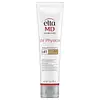What's inside
What's inside
 Key Ingredients
Key Ingredients

 Benefits
Benefits

 Concerns
Concerns

 Ingredients Side-by-side
Ingredients Side-by-side

Butyl Methoxydibenzoylmethane 3%
UV AbsorberEthylhexyl Salicylate 5%
UV AbsorberOctocrylene 10%
UV AbsorberWater
Skin ConditioningPropanediol
SolventButyloctyl Salicylate
Skin ConditioningGlycerin
HumectantC12-15 Alkyl Benzoate
AntimicrobialPolymethylsilsesquioxane
Niacinamide
SmoothingGlyceryl Stearate Citrate
EmollientCI 77163
Cosmetic ColorantMica
Cosmetic ColorantTitanium Dioxide
Cosmetic ColorantLauryl Lactate
EmollientIsododecane
EmollientIsodecyl Neopentanoate
EmollientGlyceryl Stearate
EmollientDiisopropyl Sebacate
EmollientCetyl Phosphate
EmulsifyingCaprylic/Capric Triglyceride
MaskingCoco-Caprylate
EmollientEthylhexyl Hydroxystearate
EmollientButylene Glycol
HumectantArginine
MaskingHydroxyacetophenone
AntioxidantCaprylyl Glycol
Emollient1,2-Hexanediol
Skin ConditioningIron Oxides
Sodium Hyaluronate
HumectantChlorphenesin
AntimicrobialAcrylates/C10-30 Alkyl Acrylate Crosspolymer
Emulsion StabilisingTrisodium Ethylenediamine Disuccinate
Phospholipids
Skin ConditioningLimonium Gerberi Extract
Skin ProtectingLeuconostoc/Radish Root Ferment Filtrate
AntimicrobialTheobroma Cacao Seed Extract
AntioxidantPantothenic Acid
Skin ConditioningTocopherol
AntioxidantHelianthus Annuus Seed Oil
EmollientFerulic Acid
AntimicrobialButyl Methoxydibenzoylmethane 3%, Ethylhexyl Salicylate 5%, Octocrylene 10%, Water, Propanediol, Butyloctyl Salicylate, Glycerin, C12-15 Alkyl Benzoate, Polymethylsilsesquioxane, Niacinamide, Glyceryl Stearate Citrate, CI 77163, Mica, Titanium Dioxide, Lauryl Lactate, Isododecane, Isodecyl Neopentanoate, Glyceryl Stearate, Diisopropyl Sebacate, Cetyl Phosphate, Caprylic/Capric Triglyceride, Coco-Caprylate, Ethylhexyl Hydroxystearate, Butylene Glycol, Arginine, Hydroxyacetophenone, Caprylyl Glycol, 1,2-Hexanediol, Iron Oxides, Sodium Hyaluronate, Chlorphenesin, Acrylates/C10-30 Alkyl Acrylate Crosspolymer, Trisodium Ethylenediamine Disuccinate, Phospholipids, Limonium Gerberi Extract, Leuconostoc/Radish Root Ferment Filtrate, Theobroma Cacao Seed Extract, Pantothenic Acid, Tocopherol, Helianthus Annuus Seed Oil, Ferulic Acid
Zinc Oxide 9%
Cosmetic ColorantTitanium Dioxide 7%
Cosmetic ColorantWater
Skin ConditioningIsopropyl Palmitate
EmollientEthylhexyl Stearate
EmollientOctyldodecyl Neopentanoate
EmollientAlumina
AbrasivePolyacrylate-13
Phenoxyethanol
PreservativeHydrogen Dimethicone
Polyisobutene
Hydrogenated Polyisobutene
EmollientTriethoxycaprylylsilane
Oleth-3 Phosphate
Tocopheryl Acetate
AntioxidantBisabolol
MaskingTocopherol
AntioxidantCarnosine
Skin ConditioningEthylhexylglycerin
Skin ConditioningSorbitan Isostearate
EmulsifyingPolysorbate 20
EmulsifyingZingiber Officinale Root Extract
MaskingIron Oxides
Zinc Oxide 9%, Titanium Dioxide 7%, Water, Isopropyl Palmitate, Ethylhexyl Stearate, Octyldodecyl Neopentanoate, Alumina, Polyacrylate-13, Phenoxyethanol, Hydrogen Dimethicone, Polyisobutene, Hydrogenated Polyisobutene, Triethoxycaprylylsilane, Oleth-3 Phosphate, Tocopheryl Acetate, Bisabolol, Tocopherol, Carnosine, Ethylhexylglycerin, Sorbitan Isostearate, Polysorbate 20, Zingiber Officinale Root Extract, Iron Oxides
 Reviews
Reviews

Ingredients Explained
These ingredients are found in both products.
Ingredients higher up in an ingredient list are typically present in a larger amount.
Titanium dioxide is a mineral UV filter widely used in sunscreens and cosmetics.
It is one of only two UV filters officially classified as “mineral” by regulatory agencies, the other being zinc oxide.
Titanium dioxide provides broad-spectrum protection mostly in the UVB and UVAII range, with some protection in the UVAI range.
While its UVA protection isn’t as strong as zinc oxide’s, the difference is minor.
A common myth is that mineral UV filters reflect UV light. However, modern research shows titanium dioxide absorbs UV radiation like chemical filters (~95% absorption & 5% reflection).
Thanks to its non-irritating nature, titanium dioxide is suitable for sensitive, acne-prone, or redness-prone skin. It is unlikely to cause "eye sting" like other sunscreen ingredients.
A major drawback of this ingredient is its white cast and thick texture. This is why mineral sunscreens often leave a white cast and are less cosmetically elegant than chemical/hybrid sunscreens.
To improve white cast and spreadability, micronized or nano-sized titanium dioxide is often used.
There are ongoing concerns surrounding nano-titanium oxide's impact on marine ecosystems.
There is no conclusive evidence that any form of titanium oxide (or any other sunscreen ingredients) will cause harm to marine ecosystems or coral reefs. The science is still developing but many consumers are keeping a close eye on this issue.
Please note, many destinations have reef-safety sunscreen rules. For instance, the U.S. Virgin Islands advises all visitors to use non-nano mineral sunscreens.
Nano mineral sunscreens once raised safety concerns about absorption into skin.
Extensive research has shown that they do not penetrate healthy or damaged skin; they remain safely on the surface and the top layer of dead skin (stratum corneum).
You'll likely find titanium dioxide bundled with alumina, silica, or dimethicone. These ingredients help make titanium dioxide highly photostable; this prevents it from interacting with other formula components under UV light.
Learn more about Titanium DioxideTocopherol (also known as Vitamin E) is a common antioxidant used to help protect the skin from free-radicals and strengthen the skin barrier. It's also fat soluble - this means our skin is great at absorbing it.
Vitamin E also helps keep your natural skin lipids healthy. Your lipid skin barrier naturally consists of lipids, ceramides, and fatty acids. Vitamin E offers extra protection for your skin’s lipid barrier, keeping your skin healthy and nourished.
Another benefit is a bit of UV protection. Vitamin E helps reduce the damage caused by UVB rays. (It should not replace your sunscreen). Combining it with Vitamin C can decrease sunburned cells and hyperpigmentation after UV exposure.
You might have noticed Vitamin E + C often paired together. This is because it is great at stabilizing Vitamin C. Using the two together helps increase the effectiveness of both ingredients.
There are often claims that Vitamin E can reduce/prevent scarring, but these claims haven't been confirmed by scientific research.
Learn more about TocopherolWater. It's the most common cosmetic ingredient of all. You'll usually see it at the top of ingredient lists, meaning that it makes up the largest part of the product.
So why is it so popular? Water most often acts as a solvent - this means that it helps dissolve other ingredients into the formulation.
You'll also recognize water as that liquid we all need to stay alive. If you see this, drink a glass of water. Stay hydrated!
Learn more about WaterThis ingredient is a combination of red, black, and yellow iron oxide pigments. This combination of colors is usually found in foundation, because it results in a "skin" color.